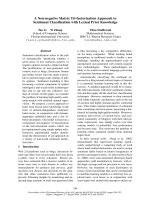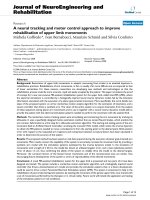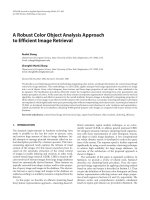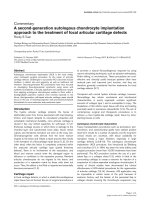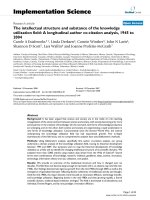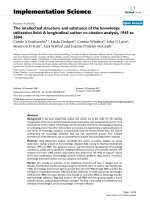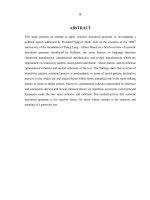A systemic functional multimodal discourse analysis approach to pedagogic discourse
Bạn đang xem bản rút gọn của tài liệu. Xem và tải ngay bản đầy đủ của tài liệu tại đây (7.94 MB, 477 trang )
A SYSTEMIC FUNCTIONAL
MULTIMODAL DISCOURSE ANALYSIS APPROACH TO
PEDAGOGIC DISCOURSE
LIM FEI VICTOR
NATIONAL UNIVERSITY OF SINGAPORE
2011
A SYSTEMIC FUNCTIONAL
MULTIMODAL DISCOURSE ANALYSIS APPROACH TO
PEDAGOGIC DISCOURSE
LIM FEI VICTOR
BA Hons (NUS), MA (NUS), PGDE (NIE)
A THESIS SUBMITTED
FOR THE DEGREE OF DOCTOR OF PHILOSOPHY
DEPARTMENT OF ENGLISH LANGUAGE AND LITERATURE
NATIONAL UNIVERSITY OF SINGAPORE
2011
ii | P a g e
This thesis represents my own work and due acknowledgment is given whenever
information is derived from other sources. No part of this thesis has been or is being
concurrently submitted for any other qualification at any university.
Lim Fei Victor
iii | P a g e
DEDICATION
In loving memory
of my grandmother
Mdm Chong Chew Yong (1929-2007)
iv | P a g e
ACKNOWLEDGEMENTS
I am profoundly indebted to Professor Kay O’Halloran, my Supervisor & Director,
Multimodal Analysis Lab, Interactive Digital Media Institute, National University
of Singapore. Thank you for apprenticing me into the field of multimodal
research more than a decade ago and for being the visionary who pioneered the
SF-MDA approach to multimodal text.
I thank God for my wife, Yvonne, my sons, Alden and Avern, and my soon-to-be-
born daughter, Arielle. Yv, thank you for being an amazing woman who took such
good care of the family and for giving me the freedom to pursue my dream. It is
your unwavering support and unceasing love that made this journey possible.
I am grateful to Mrs Angela Ow, former Director, Training & Development
Division, Ministry of Education, Singapore. Thank you for believing in this young
man enough to recommend him for the MOE Postgraduate Scholarship.
I am thankful to Mr Koh Yong Chiah, former Principal, Jurong Junior College.
Thank you for teaching me to have the mind of a contrarian and the heart of an
educator.
v | P a g e
This thesis is also made possible with the generous assistance of:
Mr Joseph Lew, for his help with the marcos program in Excel.
Ms Jelaine Ang, for her editing and proof-reading.
Dr Alexey Podlasov, Research Fellow, Multimodal Analysis Lab, for his
advice on the use of Cytoscape.
Ms Patricia Lim, Head of English, Jurong Junior College.
Participating Teachers from Jurong Junior College: Ms Eleen Tan, Mrs Joey
Tan, Ms Patricia Lim, Mr Ravi Shankar, Mr Timothy Dore and Mr Tsering
Wanyal.
Ms Felicia Yip, Year Two Level Head, General Paper, Jurong Junior College.
vi | P a g e
The research for this thesis is supported by Interactive Digital Media Programme
Office (IDMPO) in Singapore under the National Research Foundation’s (NRF)
Interactive Digital Media R&D Programme (Grant Number: NRF2007IDM-IDM002-
066).
This thesis is also funded by the Ministry of Education, Singapore, Postgraduate
Scholarship and the National University of Singapore, Research Scholarship.
The images in Figure 5.20A-B are created by Tagxedo, and their derivatives, are
licensed under a Creative Commons Attribution-Noncommercial-ShareAlike License
3.0, and must be attributed to .
vii | P a g e
TABLE OF CONTENTS
STATEMENT II
DEDICATION III
ACKNOWLEDGEMENTS IV
TABLE OF CONTENTS VII
LIST OF FIGURES XIII
LIST OF TABLES XVI
SUMMARY XVIII
CHAPTER 1
MULTIMODALITY AND LITERACY 1
1.1 Research Terrain 1
1.1.1 Thesis 1
1.1.2 Research Questions and Aims 6
1.2 Research Field 10
1.2.1 Literacy 10
1.2.1.1 Literacy is Social 12
1.2.1.2 Literacy is Material 13
1.2.1.3 Literacy is Semiotic 15
1.2.2 Multimodality 17
1.2.2.1 Multimodality as Phenomenon 19
1.2.2.1.1 Challenges to Paradigm 21
1.2.2.2 Multimodality as Domain of Enquiry 23
1.2.2.2.1 Challenges to Perspective 27
1.2.2.3 Multimodality as Analytical Approach 39
1.2.2.3.1 Challenges to Practice 42
viii | P a g e
1.2.3 Multimodality in the Classroom 45
1.2.4 Multimodal Literacy 47
1.2.4.1 Multimodal Literacy in Multimedia Texts 49
1.2.4.2 Multimodal Literacy in Multisemiotic Experience 55
1.3. Research Application 53
1.3.1 Multimodal Pedagogic Discourse 55
1.4. Summary 61
CHAPTER 2
METHODOLOGY AND ORIENTATION 64
2.1 Methodology 64
2.1.1 Current Approaches to Classroom Discourse 64
2.1.2 Systemic Functional Multimodal Discourse Analysis (SF-MDA) 69
2.1.2.1 Systemic 72
2.1.2.2 Functional 76
2.1.2.3 Multimodal 79
2.1.2.4 Discourse 80
2.1.2.5 Analysis 82
2.2. Orientation 85
2.2.1 Quadnocular Theoretical Perspective 85
2.2.2 Diachronic and Synchronic Analytical Views 89
2.3 Summary 95
CHAPTER 3
CONTEXTUALISATION FROM IDEOLOGY TO INSTANCE 96
3.1 Resemiotization 96
3.1.1 Singapore’s Educational Landscape 101
ix | P a g e
3.1.2 Singapore Ministry of Education’s Desired Outcomes of Education 102
3.1.3 The Ministry of Education’s Advanced Level
Curriculum Framework 103
3.1.4 General Paper in the Ministry of Education’s
Curriculum Documents 107
3.1.5 General Paper in the English Department’s Scheme of Work 111
3.1.6 Accretive Learning in General Paper 115
3.2. Curriculum Genre Theory 118
3.2.1 Curriculum Macrogenre & Curriculum Genre 120
3.2.2 Curriculum Hypergenre 125
3.2.3 Lesson Genres and Lesson Microgenre 131
3.2.3.1 Contextual Configuration of Lesson Microgenre: Field 135
3.2.3.2 Contextual Configuration of Lesson Microgenre: Tenor 139
3.2.3.3 Contextual Configuration of Lesson Microgenre: Mode 141
3.2.4 Lesson Microgenres in the General Paper Lesson 149
3.3. Summary 151
CHAPTER 4
GESTURE AND SPATIAL PEDAGOGY 154
4.1 Gesture Studies 154
4.1.1 Communicative Gesture and Performative Gesture 157
4.1.2 Systemic Functional Approach to Gesture 160
4.1.3 Descriptions of Gesture 164
4.1.4 Formal Description of Gesture 165
4.1.5 Functional Description of Gesture: Metafunctional Organisation 167
4.1.5.1 Ideational Meanings in Gesture 167
4.1.5.1.1 Presenting Action 167
4.1.5.1.2 Representing Action 173
x | P a g e
4.1.5.1.1 Indexical Action 178
4.1.5.2 Interpersonal Meanings in Gesture 184
4.1.5.3 Textual Meanings in Gesture 190
4.1.6 Summary of Approach to Gesture 193
4.2. Spatial Pedagogy 196
4.2.1 Types of Space in the Classroom 199
4.2.2 Summary of Approach to the Use of Space 204
CHAPTER 5
APPROACH AND ANALYSIS 207
5.1 Approach in Study 208
5.1.1 Collection of Data 208
5.1.2 Annotation of Data 213
5.1.2.1 Categories of Annotations 215
5.1.3 Analysis and Visualisation of Data 219
5.2 Logogenesis of the Lessons 224
5.2.1 Categories of Lesson Microgenre 224
5.2.2 Lesson Microgenres 229
5.2.2.1 Lesson Initiation 231
5.2.2.2 Lesson Progress 235
5.2.2.3 Lesson Diversion 242
5.2.2.4 Lesson Closure 246
5.2.3 Comparison of the Lesson Microgenres in Wilson
and Adeline’s Lesson 251
5.3 Gesture Analysis 259
5.3.1 Formal Selections in Gesture 259
5.3.2 Functional Meanings in Gesture 271
5.3.2.1 Ideational Meanings 271
xi | P a g e
5.2.2.1.1 Presenting Action 271
5.3.2.1.2 Representing Action 274
5.2.2.1.2 Indexical Action 277
5.3.2.2 Interpersonal Meanings 280
5.2.2.3 Textual Meanings 284
5.4 Space & Movement Analysis 288
5.4.1 Analysis of Space 293
5.4.2 Analysis of Movement 296
5.5 Analysis of Language 297
5.5.1 Word Cloud Analysis 298
5.5.2 Systemic Functional Grammar Analysis 300
5.6 Summary of Wilson and Adeline’s Pedagogy 306
CHAPTER 6
INTERSEMIOSIS IN PEDAGOGIC DISCOURSE 316
6.1 Intersemiosis 316
6.2 Nexus in Intersemiosis 319
6.2.1 Contextualising Relations 319
6.2.2 Intersemiotic Mechanisms 324
6.3 Intersemiosis in Gesture and Language 328
6.3.1 Indexical Action and Language 328
6.3.2 Representing Action and Language 332
6.4 Nature of Intersemiosis 336
6.4.1 Redundancy 336
6.4.2 Structured Informality 340
6.5 Summary 344
xii | P a g e
CHAPTER 7
CONTRIBUTIONS, IMPLICATIONS AND LIMITATIONS 346
7.1 Contributions 346
7.1.1 Theoretical Contributions 347
7.1.2 Methodological Contributions 352
7.2. Implications 357
7.2.1 Educational Implications 357
7.2.2 Pedagogical Implications 359
7.3 Limitations and Further Research 366
7.4 Conclusion 369
REFERENCES 371
APPENDIX I
The New A-Level Curriculum 391
APPENDIX II
General Paper Syllabus 394
APPENDIX III
General Paper Examination Exemplar 398
APPENDIX IV
General Paper Scheme of Work 408
APPENDIX V
Annotation Exemplar for 12 seconds of Wilson & Adeline’s lesson 418
xiii | P a g e
LIST OF FIGURES
Figure 3.1 Model on Contextualisation 99
Figure 3.2 Singapore-Cambridge General Certificate of Education
(Advanced Level) Curriculum 105
Figure 3.3 Skills & Content Topics in General Paper 114
Figure 3.4 Cyclical Learning in General Paper 117
Figure 3.5 Linear Curriculum Macrogenre 122
Figure 3.6 Orbital Curriculum Macrogenre 124
Figure 3.7A Networked Curriculum Hypergenre in Circular Layout 127
Figure 3.7B Networked Curriculum Hypergenre in Hierarchical Layout 128
Figure 3.8 Lesson Microgenres in General Paper 133
Figure 3.9 Socio-Semiotic Processes 136
Figure 3.10 Hall’s (1996) Distance Sets 140
Figure 3.11 Whiteboard for Reinforcement of Knowledge 143
Figure 3.12 Whiteboard for Reformulation of Knowledge 143
Figure 3.13 Whiteboard for Explanation and Elaboration of Knowledge 145
Figure 3.14 Whiteboard for Organisation of Knowledge 145
Figure 4.1 Classification of Gesture 161
Figure 4.2 Presenting Action 168
Figure 4.3 Ideational Meanings in Presenting Action 169
Figure 4.4 State Processes 171
Figure 4.5 Mental Processes 172
Figure 4.6 Ideational Meanings in Representing Action 173
Figure 4.7 Language Independent Gestures 174
Figure 4.8 Language Correspondent Gestures 175
Figure 4.9 Representing Action of ‘Stop’ 175
xiv | P a g e
Figure 4.10 Ideational Meanings in Indexical Action 179
Figure 4.11 Indexical Action realising the representation of Importance 180
Figure 4.12 Indexical Action realising the representation of Receptivity 180
Figure 4.13 Indexical Action realising the representation of Relation 181
Figure 4.14 Indexical Action realising Defensiveness and Disapproval 183
Figure 4.15 Indexical Action realising Assertiveness 183
Figure 4.16 Dimensions of Appraisal 185
Figure 4.17 Positive and Negative Attitudes in Gesture 186
Figure 4.18 Dimensions of Engagement 188
Figure 4.19 Expansion and Contraction of Negotiation Space 189
Figure 4.20 Representation of Possibility 189
Figure 4.21 Interpersonal Meanings in Representing and Indexical Actions 190
Figure 4.22 Textual Meanings in Representing and Indexical Actions 191
Figure 4.23 Pointing at Interfaces displaying Information 193
Figure 4.24 Pointing at Students 193
Figure 4.25 Classroom Front Centre (Authoritative Space) 201
Figure 4.26 Around the Teacher’s Desk (Personal Space) 201
Figure 4.27 Around the Teacher's Desk (Authoritative Space) 202
Figure 4.28 Wilson's Use of Supervisory Space 202
Figure 5.1 Rifatron’s eight Cameras Interface 209
Figure 5.2 Annotations Exemplar 218
Figure 5.3A Top 5 Lesson Microgenre in Wilson’s Lesson 251
Figure 5.3BA Top 5 Lesson Microgenre in Adeline’s Lesson 251
Figure 5.4A Wilson’s Lesson Microgenre 255
Figure 5.4B Adeline’s Lesson Microgenre 256
Figure 5.5 Adeline Pointing 261
Figure 5.6 Wilson Pointing 261
xv | P a g e
Figure 5.7 Adeline in Hands Joint, Palms-Down and Palms-Open Gesture 262
Figure 5.8 Wilson in Hands Joint, Palms-Down and Palms-Open Gesture 262
Figure 5.9 Wilson Leaning Forward 262
Figure 5.10 Contact with Whiteboard 267
Figure 5.11 Contact with Notes 267
Figure 5.12 Contact with Laptop 268
Figure 5.13 Contact with Visualiser 268
Figure 5.14 Hands at Waist Level 270
Figure 5.15 Hands at Legs Level 270
Figure 5.16 Hands at Chest Level 271
Figure 5.17 Language Correspondent Gestures 275
Figure 5.18A Wilson’s Positioning & Movement Graph 290
Figure 5.18B Adeline’s Positioning & Movement Graph 291
Figure 5.19 Adeline Behind the Teacher’s Desk 295
Figure 5.20A Wilson’s Language 298
Figure 5.20B Adeline’s Language 298
xvi | P a g e
LIST OF TABLES
Table 5.1 Annotation Categories and Parameters 216
Table 5.2 Categories of Lesson Microgenre in the Lessons 225
Table 5.3 Logogenesis of the Lessons 226
Table 5.4 Lesson Microgenres 230
Table 5.5 Directionality of Gesture 260
Table 5.6 Description of Hands 260
Table 5.7 Use of Hands 263
Table 5.8 Contact 265
Table 5.9 Hands Level 268
Table 5.10 Types of Actions 272
Table 5.11 Processes in Presenting Action 272
Table 5.12 Processes in Presenting Action across Lesson 273
Table 5.13 Representing Entities 276
Table 5.14 Indexical Representation 279
Table 5.15 Attitude 281
Table 5.16 Graduation 281
Table 5.17 Engagement 282
Table 5.18 Beats 285
Table 5.19 Specificity of Pointing 285
Table 5.20 Directionality of Pointing 286
Table 5.21 Statistical Analysis of the Use of Space 292
Table 5.22 Modality 301
Table 5.23 Transitivity 306
Table 5.24 Categories of Lesson Microgenre Comparisons 302
Table 5.25 Lesson Microgenres Comparisons 308
Table 5.26 Use of Gesture Comparisons 310
xvii | P a g e
Table 5.27 Use of Space Comparisons 312
Table 5.28 Use of Language Comparisons 313
xviii | P a g e
SUMMARY
My thesis adopts the Systemic Functional Multimodal Discourse Analysis (SF-MDA)
approach to investigate pedagogic discourse. Two lessons of the subject General
Paper in a Junior College in Singapore are analysed. The semiotic resources of
language, gesture and the use of space through the positioning and movement of
the two teachers are discussed in relation to the pedagogy that they realise.
Chapter 1 relates the research field and discusses definitions of literacy and
multimodality. Multimodality is described as a phenomenon, domain of enquiry and
an analytical approach. The respective challenges to paradigm, perspective and
practice are presented. Multimodal literacy in multimedia texts and multisemiotic
experiences are also explicated. Finally, multimodal pedagogic discourse is
introduced as the research application in this study.
The SF-MDA approach adopted in this thesis is explained in Chapter 2 against
the backdrop of current approaches to classroom discourse. The ‘quadnocular
perspective’ applied in this study is introduced. The diachronic and synchronic
analytical views adopted in the analysis are described in terms of time and space as
‘integral resources’.
Chapter 3 focuses on contextualisation. The context of culture is described
through the notion of resemiotization. The resemiotization of the Ministry of
Education’s policy documents to the General Paper classroom practices is discussed.
The Curriculum Genre Theory is applied to multimodal pedagogic discourse and is
xix | P a g e
productive in locating the lesson in the context of situation. The Curriculum
Hypergenre is proposed along with a set of Lesson Microgenres formulated for the
General Paper classroom.
Gesture and spatial pedagogy are discussed in Chapter 4. The categories of
Communicative Gesture and Performative Gestures are proposed and both formal
and functional descriptions of gesture are annotated in the analysis. Presenting,
Representing and Indexical Actions are described in terms of their systems in the
metafunctional organisation. In addition, the different types of space in the
classroom are also proposed.
Chapter 5 describes the approach and presents the findings from the analysis
of the multimodal corpus. The approach in the collection, annotation, analysis and
visualisation of the data is outlined. The analysis is discussed in accordance to the
lesson microgenres, gesture, use of space through positioning and movement as well
as language. The visualisation of the patterns and trends in the logogenesis of the
teachers’ lessons and their use of space are displayed through state transition
diagrams. The dominances and tendencies observed in the statistical results are
contrasted between the two teachers. With that, the distinct pedagogies they realise
in their lesson through their multimodal semiotic selections are described.
An integrative perspective on the co-deployment of semiotic resources is
presented in Chapter 6. Specifically, the intersemiosis between language and gesture
is described in terms of contextualising relations and intersemiotic cohesion. The
xx | P a g e
emergent meanings of ‘Redundancy’ and ‘Structured Informality’ in the lessons
observed are also discussed.
Finally, Chapter 7 concludes with the theoretical and methodological
contributions along with the educational and pedagogical implications arising from
this thesis. The limitations of this study are also discussed along with possible further
research endeavours.
1 | P a g e
CHAPTER 1
MULTIMODALITY AND LITERACY
1.1 Research Terrain
1.1.1 Thesis
What makes an effective teacher? How do we distinguish one from the other? Is it in
their capacity to inspire, their creativity to interest or their capability to impart? If so,
how are these intangibles embodied by the teacher and demonstrated in the lesson?
Also, how do we measure them?
My thesis is that an investigation of the teacher’s use of language, gesture,
positioning and movement in the lesson may provide insights into their distinct
pedagogies. Teaching and learning in the classroom is a multisemiotic experience.
Hence, in order to access the constellation of meanings made in the orchestration of
multisemiotic choices by the teacher, a multimodal analysis afforded by multimedia
techniques is productive. This is the endeavour undertaken in my thesis. Specifically,
two teachers’ use of semiotic resources in a General Paper lesson at a school in
Singapore is investigated in this study.
The importance of the teacher has been increasingly accentuated in the last
few years in Singapore. Most recently, the Ministry of Education, Singapore, in
December 2010, presented its report by the committee on Secondary Education
Review and Implementation (SERI). One of the key recommendations by SERI is the
2 | P a g e
need to “re-tune our system to strengthen the rapport between teacher and
students”
1
. The belief is that “[a]s teachers are the frontline in the delivery of holistic
education, strong teacher-student relationships will facilitate the school’s ability to
provide greater social-emotional support to students” (Ministry of Education,
Singapore, 2010: 23). Further, the Ministry of Education recognises that as “teachers
have an immediate influence on students’ academic-related interests, the link
between a student’s academic outcomes and teacher support is strong and direct”
(Ministry of Education, Singapore, 2010: 30).
The growing recognition of the critical role teachers have in education is
founded on many recent studies; for instance, the survey conducted by global
consulting firm, McKinsey & Company (2007) entitled, How the world’s best
performing school systems come out on top. The study involves 25 school systems
worldwide, including Singapore, which was ranked amongst the top five best
performing systems. There are three simple guiding principles that the report cites
for success. They are namely 1) getting the right people to become teachers, 2)
developing them into effective educators and 3) ensuring that the system is able to
deliver the best possible instruction for every child. The McKinsey study concludes
that the main driver of learning and performance is in the quality of the teachers.
The study also asserts that the quality of the education system cannot exceed the
quality of its teaching force.
In tandem with these studies, increasing effort has been made in the aspect
of teacher-training in Singapore. The Ministry of Education launched the GROW
1
3 | P a g e
(Growth of education officers, through better Recognition, Opportunities, and seeing
to their Well-being) Package in 2006 and GROW 2.0 in 2008 to further reward
teachers in remuneration and welfare benefits. The policy also incentivises teachers’
lifelong learning and upgrading of their professional qualifications through the
provision of scholarships and sabbatical leave schemes. GROW 2.0 was designed to
build on the foundation of the GROW package, incepted in 2006, to further support
teachers’ professional and personal development needs holistically. This is to attract
and retain a quality teaching force.
2
The enhanced benefits for teachers are
estimated to cost the Singapore Government about SGD 380 million
3
. This
dissertation research is, in part, funded by the postgraduate scholarship and
professional leave scheme from the GROW package.
The focus on teachers in education, however, has not always been that
intense. Christie (2007: 6) observes that up till recently, “[c]urriculum theorizing
throughout the twentieth century was significantly influenced by various
progressivist and constructivist theories of knowledge and of the learner, whose
effect was to diminish the status of knowledge structures, as well as the role of the
teacher”.
Nonetheless, there have also been many education researchers who have
been vocal in asserting the importance of the teacher in the classroom. For instance,
Muller (2007: 26) describes the teacher as “an authoritative pedagogical agent”.
Muller (2007) argues for sound teacher’s competency and strong knowledge
2
3
4 | P a g e
expertise, opining that “the condition for teachers to be able to induct pupils into
strong internal grammar subjects is that they themselves already stand on the
shoulders of giants that they can speak with the disciplinary grammar”. Muller
(2007: 26) notes that in his survey of the global literature on effective learning,
“teacher competence is by far the most important factor in learner attainment”.
This resonates with Macken-Horarik, Love & Unsworth’s (2011) study of the
English classroom. They argue that “*t+eachers are central… [as] teachers are the
ones who will need to revise, or indeed establish, a grammar that relates
purposefully to the texts of contemporary school English and builds knowledge
about language progressively and cumulatively” (Macken-Horarik et al. 2011: 10). In
other words, teachers’ competency is vital to their effectiveness in the classroom.
O’Halloran (2007a) also highlights the importance of the teacher in her
documentation of the difference in teaching and learning practices in Mathematics
classrooms that are differentiated on the basis of socio-economic status. She
observes that “as the divide grows between different types of schools, so do the
experiences, qualifications and salary of the teaching staff” (O’Halloran, 2007: 235).
As such, O’Halloran (2007a: 235) argues for the need to “develop theoretical and
practical approaches for developing effective teaching strategies, particularly for
teachers working with disadvantaged students”. O’Halloran (2007a) emphasises the
importance of teacher-training, crediting the teacher as a critical factor in the
outcome of the students’ achievements in Mathematics.

